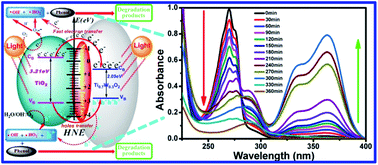当前位置:
X-MOL 学术
›
Nanoscale Adv.
›
论文详情
Our official English website, www.x-mol.net, welcomes your
feedback! (Note: you will need to create a separate account there.)
Preparation of a Ti0.7W0.3O2/TiO2 nanocomposite interfacial photocatalyst and its photocatalytic degradation of phenol pollutants in wastewater
Nanoscale Advances ( IF 4.6 ) Pub Date : 2019/12/12 , DOI: 10.1039/c9na00478e Zemin Dong 1, 2 , Rendan Zhou 3 , Leyan Xiong 1 , Han Li 4 , Qiang Liu 1 , Longzhen Zheng 1 , Zanru Guo 1 , Zhaoxiang Deng 5
Nanoscale Advances ( IF 4.6 ) Pub Date : 2019/12/12 , DOI: 10.1039/c9na00478e Zemin Dong 1, 2 , Rendan Zhou 3 , Leyan Xiong 1 , Han Li 4 , Qiang Liu 1 , Longzhen Zheng 1 , Zanru Guo 1 , Zhaoxiang Deng 5
Affiliation

|
A Ti0.7W0.3O2/TiO2 nanocomposite interfacial photocatalyst was designed and prepared for the photocatalytic degradation of phenol pollutants in wastewater. The detailed properties of the Ti0.7W0.3O2/TiO2 nanocomposite interface (NCI) were analyzed by XRD, SEM, EDX, DRS, UPS and XPS technologies, showing that anatase TiO2 nanospheres (NSs) were uniformly dispersed on the surface of rutile Ti0.7W0.3O2 nanoparticles (NPs) and formed the nanocomposite interface. The DRS and UPS results of 5 wt% Ti0.7W0.3O2/TiO2 NCI indicated a greatly broadened light response range with a wavelength shorter than 527 nm and a shorter band gap energy of 2.37 eV. The conduction band of TiO2 NSs, Ti0.7W0.3O2 NPs and 5 wt% Ti0.7W0.3O2/TiO2 NCI were measured based on the results of the valence band and band gap energy obtained via XPS and DRS, and then the energy level diagram of Ti0.7W0.3O2/TiO2 NCI was proposed. The photocatalytic degradation of phenol at Ti0.7W0.3O2/TiO2 NCI with different loading ratios of Ti0.7W0.3O2 NPs was investigated under optimum conditions (i.e., pH of 4.5, catalyst dosage of 0.45 g L−1 and phenol initial concentration of 95 ppm) under the illumination of ultraviolet visible light. Also, 5 wt% Ti0.7W0.3O2/TiO2 NCI exhibited the highest photocatalytic activity, with the initial rate constant (k) calculated as 0.09111 min−1. After recycling six times, Ti0.7W0.3O2/TiO2 NCI showed good stability and recyclability. The involvement of superoxide radicals in the initial reaction at Ti0.7W0.3O2/TiO2 NCI was evidenced by the use of a terephthalic acid (TA) fluorescent probe. Besides, UV-Vis spectroscopy, UHPLC-MS and GC-MS technologies were used to analyze the main intermediates in the photocatalytic degradation of phenol. The probable photocatalytic degradation mechanism of phenol at Ti0.7W0.3O2/TiO2 NCI was also proposed.
中文翻译:

TiO.7W0.3O2/TiO2纳米复合界面光催化剂的制备及其光催化降解废水中酚类污染物
设计制备了一种Ti 0.7 W 0.3 O 2 /TiO 2纳米复合界面光催化剂,用于光催化降解废水中的苯酚类污染物。通过XRD、SEM、EDX、DRS、UPS和XPS等技术对Ti 0.7 W 0.3 O 2 /TiO 2纳米复合界面(NCI)的详细性能进行分析,表明锐钛矿型TiO 2纳米球(NSs)均匀分散在表面金红石Ti 0.7 W 0.3 O 2纳米颗粒(NPs)形成纳米复合界面。5 wt% Ti 0.7 W的DRS和UPS结果0.3 O 2 /TiO 2 NCI 表明光响应范围大大拓宽,波长小于527 nm,带隙能量更短,为2.37 eV。TiO 2 NSs、Ti 0.7 W 0.3 O 2 NPs 和 5 wt% Ti 0.7 W 0.3 O 2 /TiO 2 NCI 的导带基于通过XPS 和 DRS获得的价带和带隙能量的结果测量,并且然后是Ti 0.7 W 0.3 O 2 /TiO 2的能级图提出了 NCI。研究了不同负载率Ti 0.7 W 0.3 O 2 NPs在Ti 0.7 W 0.3 O 2 /TiO 2 NCI下光催化降解苯酚的最佳条件(即pH为4.5、催化剂用量为0.45 g L -1和苯酚)。初始浓度为 95 ppm)在紫外可见光照射下。此外,5 wt% Ti 0.7 W 0.3 O 2 /TiO 2 NCI 表现出最高的光催化活性,初始速率常数 ( k ) 计算为 0.09111 min -1. Ti 0.7 W 0.3 O 2 /TiO 2 NCI经6次循环利用后表现出良好的稳定性和可循环性。使用对苯二甲酸 (TA) 荧光探针证明了在 Ti 0.7 W 0.3 O 2 /TiO 2 NCI初始反应中超氧自由基的参与。此外,还采用紫外-可见光谱、UHPLC-MS和GC-MS技术对苯酚光催化降解的主要中间体进行了分析。还提出了在Ti 0.7 W 0.3 O 2 /TiO 2 NCI下苯酚可能的光催化降解机理。
更新日期:2020-02-13
中文翻译:

TiO.7W0.3O2/TiO2纳米复合界面光催化剂的制备及其光催化降解废水中酚类污染物
设计制备了一种Ti 0.7 W 0.3 O 2 /TiO 2纳米复合界面光催化剂,用于光催化降解废水中的苯酚类污染物。通过XRD、SEM、EDX、DRS、UPS和XPS等技术对Ti 0.7 W 0.3 O 2 /TiO 2纳米复合界面(NCI)的详细性能进行分析,表明锐钛矿型TiO 2纳米球(NSs)均匀分散在表面金红石Ti 0.7 W 0.3 O 2纳米颗粒(NPs)形成纳米复合界面。5 wt% Ti 0.7 W的DRS和UPS结果0.3 O 2 /TiO 2 NCI 表明光响应范围大大拓宽,波长小于527 nm,带隙能量更短,为2.37 eV。TiO 2 NSs、Ti 0.7 W 0.3 O 2 NPs 和 5 wt% Ti 0.7 W 0.3 O 2 /TiO 2 NCI 的导带基于通过XPS 和 DRS获得的价带和带隙能量的结果测量,并且然后是Ti 0.7 W 0.3 O 2 /TiO 2的能级图提出了 NCI。研究了不同负载率Ti 0.7 W 0.3 O 2 NPs在Ti 0.7 W 0.3 O 2 /TiO 2 NCI下光催化降解苯酚的最佳条件(即pH为4.5、催化剂用量为0.45 g L -1和苯酚)。初始浓度为 95 ppm)在紫外可见光照射下。此外,5 wt% Ti 0.7 W 0.3 O 2 /TiO 2 NCI 表现出最高的光催化活性,初始速率常数 ( k ) 计算为 0.09111 min -1. Ti 0.7 W 0.3 O 2 /TiO 2 NCI经6次循环利用后表现出良好的稳定性和可循环性。使用对苯二甲酸 (TA) 荧光探针证明了在 Ti 0.7 W 0.3 O 2 /TiO 2 NCI初始反应中超氧自由基的参与。此外,还采用紫外-可见光谱、UHPLC-MS和GC-MS技术对苯酚光催化降解的主要中间体进行了分析。还提出了在Ti 0.7 W 0.3 O 2 /TiO 2 NCI下苯酚可能的光催化降解机理。











































 京公网安备 11010802027423号
京公网安备 11010802027423号